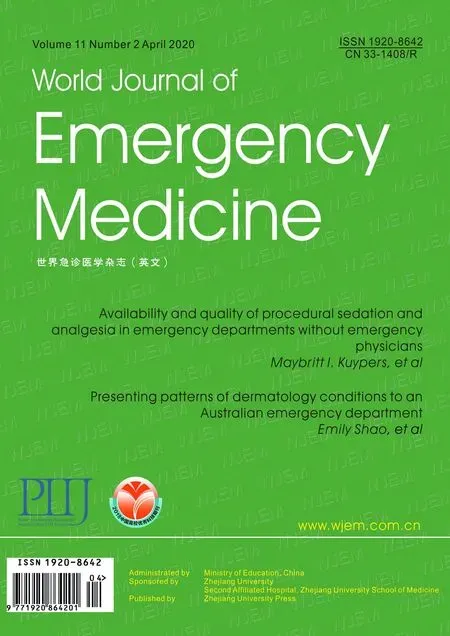Food poisoning associated methemoglobinemia: Time to wake up
Kamal Kant Sahu, Amos Lal, Ajay Mishra, Susan George
Department of Internal Medicine, Saint Vincent Hospital, Worcester, Massachusetts 01608, USA
Dear editor,
With interest we read the recent article on methemoglobinemia by Chan et al.[1]Through this letter,we would like to add few additional comments regarding methemoglobinemia and its relevance in medicine practice with regards to food poisoning.
While Chan et al[1]successfully managed their patient of methemoglobinemia and could pinpoint choy sum as the responsible agent, we wonder if there were any more cases of choy sum related to methemoglobinemia detected at the same time in the community? As per Chan et al,[1]they reported the incident to department of health and removed the vegetable samples from the market. If considered that there were no other similar cases of methemoglobinemia in the community, then the next bigger question arises that what led this patient suffer methemoglobinemia and not any other family members or community people consuming the same food sample? While, we agree that choy sum could have led to methemoglobinemia in this case, was there any other hidden or inciting agent which made this patient more vulnerable to develop methemoglobinemia than others?Did authors rule out other methemoglobinemia causing common drugs like paracetamol, local anesthetics like benzocaine spray, magic mouthwash, topical ointments like dapsone which are commonly available as overthe-counter (OTC) medications in many countries?[2,3]Not to forget the E-cigarettes and vaping related recent reports of methemoglobinemia.[4]Hence it is very important to go through the medication list of the patient, or to confirm with the primary care physician regarding potential use of any OTC medications, herbal drugs and to extract a detailed family history of the patient of any similar events in the family members in the past.[5]Any congenital cause seems to be unlikely in this elderly female but would be worth to keep autosomal congenital methemoglobinemia type I in mind, which may not have cyanosis at birth and patients usually enjoy a normal life expectancy due to milder severity of the disease.[5]Also, important to note the various other reports of methemoglobinemia secondary to food and vegetable products like fennel, meat products etc. Oxidizing agents like nitrates and nitrites are commonly used in the food industry as a preservative for meat, f ish and cheese which have been reported as a cause of methemoglobinemia and are a potential public health threat.
While Chan et al case improved with methylene blue, it is important for the readers to not to forget to check serum G6PD status of the patients before starting the treatment with methylene blue.[6]Our previous experience with ascorbic acid has been great in terms of saving lives especially in conditions when methylene blue is either contraindicated or unavailable.[7-9]
Another similar entity, sulfhemoglobinemia which clinically presents like and often confused with methemoglobinemia. Important to note that there is no available antidote for sulfmethemoglobinemia and it is usually detected when cyanosis does not improve by using methylene blue for presumed methemoglobinemia.
Another challenge while managing cases of cyanosis is the type of co-oximeter available in the medical center for the analysis of ABG samples. The capability of the co-oximeter to distinguish between methemoglobin and sulfhemoglobin is variable and hence sometimes sulfhemoglobin goes undetected, commonly referred to as pseudo-methemoglobinemia. To add to the trouble,few agents can cause both methemoglobinemia and sulfhemoglobinemia. Isoelectric focusing is a useful technique to distinguish between the two. As there is no antidote available, it is very important to remove the offending agent as soon as possible in case of sulfhemoglobinemia.
In conclusion, we congratulate Chan et al for the excellent report and for the attempt to educate the readers and physicians regarding this rare entity. We also here by emphasize that proper handling and food regulation should be maintained while selling the food products to minimize such mishap in future.
Funding:None.
Ethical approval:The article doesn’t contain the participation of any human being and animal.
Conflicts of interest:Authors have no conflicts of interest to declare.
Contributors:All authors have seen the manuscript and agreed to the content and data. All the authors played a signif icant role in the paper.
 World journal of emergency medicine2020年2期
World journal of emergency medicine2020年2期
- World journal of emergency medicine的其它文章
- Information for Readers
- Availability and quality of procedural sedation and analgesia in emergency departments without emergency physicians: A national survey in the Netherlands
- Presenting patterns of dermatology conditions to an Australian emergency department
- Effect of neutrophil CD64 for diagnosing sepsis in emergency department
- Post-dilatation improves stent apposition in patients with ST-segment elevation myocardial infarction receiving primary percutaneous intervention: A multicenter, randomized controlled trial using optical coherence tomography
- Predictive role of interleukin-6 and CAT score in mechanical ventilation in patients with chronic obstructive pulmonary disease at the acute exacerbation stage in the emergency department
